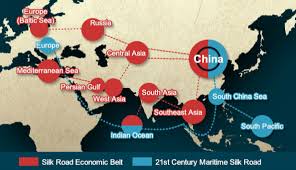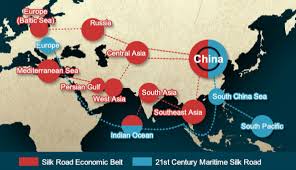
In order to splash out with its "One Belt, One Road" policy, China now wants to increase its influence by digging further into its pockets — flush with cash after decades of rapid growth.
The most populous nation on the planet has rapidly climbed the ranks to become the world's second-largest economy.
To bolster trade and development, the initiative is meant to connect Asia, Europe, the Middle East and Africa. For a two-day meeting about the policy, hordes of foreign diplomats and business leaders are expected to descend on Beijing this weekend.
Morphed into an entire chapter in the current five-year plan, to run through 2020, it was later named one of China's three major national strategies, after President Xi Jinping first announced the policy in 2013.
Using roads, ports, railway tracks, pipelines, airports, transnational electric grids and even fiber optic lines, the plan aims to connect Asia, Europe, the Middle East and Africa with a vast logistics and transport network. According to Oxford Economics, together accounting for one-third of global GDP and 60 percent of the world's population, or 4.5 billion people, the scheme involves 65 countries.
Building modern infrastructure can attract more investment and trade along the "One Belt, One Road" route and is considered to be a part of China's push to increase global clout. As it links up with neighboring countries, it could be beneficial for western China. It will help China shore up access to energy resources in the long run.
The policy might also soak up some of the overcapacity in China's heavy industry and could boost the domestic economy with demand abroad. But analysts say these are fringe benefits.
Especially after President Donald Trump pulled out of a major trade deal, the Trans-Pacific Partnership, the global leadership role that the U.S. previously filled and may now be abandoning, is being eyed by China to step into, experts say.
China still restricts foreign investment, censorship continues to be an issue and concerns remain over human rights, despite all the talk of global connectivity, skeptics highlight.
Though there is no official data on OBOR projects and spending estimates vary, most of the funding is coming via China's policy and commercial banks.
For more than 900 projects, the China Development Bank said it had reserved $890 billion in 2015. It had started financing over 1,000 projects, the Export-Import Bank of China announced early last year. Also providing financing is the China-led Asian Infrastructure Investment Bank.
According to analysis by Oxford Economics, $90 billion in loans to OBOR countries in 2016, has been estimated to have bene extended by China's big four state-owned banks. And over the next five years, China could invest as much as $500 billion in about 60 countries, Credit Suisse estimates.
Lenders will know how to manage credit risk and these countries will be able to pay China back, are the assumptions. This means that bad debts could create a strain if these projects fail to deliver as expected and this is the obvious challenge. But as infrastructure projects tend to have a long lead time, the leaks may not spring for a while.
(Source:www.cnbc.com)
The most populous nation on the planet has rapidly climbed the ranks to become the world's second-largest economy.
To bolster trade and development, the initiative is meant to connect Asia, Europe, the Middle East and Africa. For a two-day meeting about the policy, hordes of foreign diplomats and business leaders are expected to descend on Beijing this weekend.
Morphed into an entire chapter in the current five-year plan, to run through 2020, it was later named one of China's three major national strategies, after President Xi Jinping first announced the policy in 2013.
Using roads, ports, railway tracks, pipelines, airports, transnational electric grids and even fiber optic lines, the plan aims to connect Asia, Europe, the Middle East and Africa with a vast logistics and transport network. According to Oxford Economics, together accounting for one-third of global GDP and 60 percent of the world's population, or 4.5 billion people, the scheme involves 65 countries.
Building modern infrastructure can attract more investment and trade along the "One Belt, One Road" route and is considered to be a part of China's push to increase global clout. As it links up with neighboring countries, it could be beneficial for western China. It will help China shore up access to energy resources in the long run.
The policy might also soak up some of the overcapacity in China's heavy industry and could boost the domestic economy with demand abroad. But analysts say these are fringe benefits.
Especially after President Donald Trump pulled out of a major trade deal, the Trans-Pacific Partnership, the global leadership role that the U.S. previously filled and may now be abandoning, is being eyed by China to step into, experts say.
China still restricts foreign investment, censorship continues to be an issue and concerns remain over human rights, despite all the talk of global connectivity, skeptics highlight.
Though there is no official data on OBOR projects and spending estimates vary, most of the funding is coming via China's policy and commercial banks.
For more than 900 projects, the China Development Bank said it had reserved $890 billion in 2015. It had started financing over 1,000 projects, the Export-Import Bank of China announced early last year. Also providing financing is the China-led Asian Infrastructure Investment Bank.
According to analysis by Oxford Economics, $90 billion in loans to OBOR countries in 2016, has been estimated to have bene extended by China's big four state-owned banks. And over the next five years, China could invest as much as $500 billion in about 60 countries, Credit Suisse estimates.
Lenders will know how to manage credit risk and these countries will be able to pay China back, are the assumptions. This means that bad debts could create a strain if these projects fail to deliver as expected and this is the obvious challenge. But as infrastructure projects tend to have a long lead time, the leaks may not spring for a while.
(Source:www.cnbc.com)














